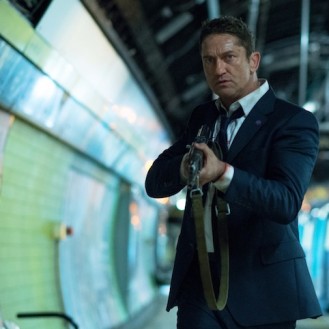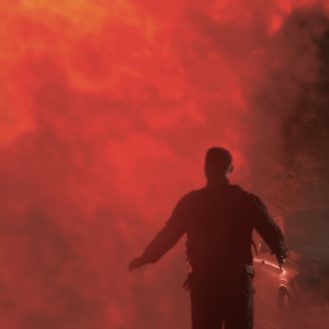By: Jolie Featherstone
From Hereditary to Midsommar, and now Beau Is Afraid, director Ari Aster has dug deeper and deeper into the primal fears and anxieties of the human psyche, while injecting seemingly personal vulnerability into his doomed protagonists’ journeys.
During a Q&A with Aster at the Toronto advance screening of Beau Is Afraid, iconic Canadian film critic, Richard Crouse, said that the movie takes viewers through a person’s “mental breakdown in real time”. It is an efficient way to illustrate the film. Beau Is Afraid is an exercise of free-association journaling. It is feeling around in the dark, eyes shrouded in a tight piece of cloth as it gages its way through thoughts and feelings that were never expressed.
During the Q&A session, Aster shared that he originally wrote a draft of the script around ten years ago. Although he’s worked on many projects since, he’s been intrigued by the world of Beau since initially putting the words down. The film was made during the pandemic; a time that Aster concedes may have subconsciously impacted his telling of the story. For Canadians reading this, here is some fun trivia: the film was shot entirely in Montreal!
The film is a blend of drama, horror, comedy, and adventure – befitting of its intuitive nature. I sense that Beau Is Afraid will be received in a similar way to Darren Aronofsky’s Mother!: audiences will either love it or despise it. Both films push viewers into areas that are not only uncomfortable, but areas to which humans have physiologically evolved to be averse. While Mother! singed viewers with a scene that enacted one of the most unnatural acts a human could conceive of, Beau Is Afraid’s subversion is more psychological in nature. Rather than the hero working through primal fears, his fears are often affirmed, or even exploited. The film is Biblical in scope, yet told in an almost episodic nature. Like Dante’s Inferno, our protagonist explores rings of personal Hells – sometimes inflicted externally, always compounded by self-imposed internal constraints. But instead of an actively intentional trek, he seems to be batted along by the waves made by people around him.
Beau (played by the incomparable Joaquin Phoenix) is a soft-spoken man who lives on his own in a dilapidated apartment. Through one of his therapy sessions, we understand that he is set to visit his mother on the anniversary of his father’s death. During this therapy session, we learn that Beau has a complex relationship with his mother. At times he seems to cherish and admire her, yet he also seems scared of her, seemingly dreading the visit home. His therapist makes a comment that tells us that there have been negative, if not toxic, situations between them in the past. Once Beau returns to his apartment and tries to get some sleep before his trip home the next day, the peripheral walls of objective reality start to fray. The point-of-view slowly begins to warp into dream logic – or perhaps nightmare logic is more apt.
An urban block party-meets-riot that constantly teeters toward violence leads to the sterile suburban home of a grieving, pill-popping, all-American couple (Nathan Lane and Amy Ryan) leads to a bohemian traveling theater troupe in a leafy forest leads to an ultimate reckoning at his family home. The film has no shortage of dripping sweat, squelching blood, and hoarse screams – but it’s not how one might typically anticipate a horror film to be. In truth, Ari Aster fans be warned: Beau Is Afraid is less about unseen intruders hiding in shadowy corners or psychedelic manipulation. It’s is more like a marathon of misery. A determined, exhausting attempt at processing emotion and thought. And yet, it is rife with pitch-black humour. While watching it in a packed theatre, you could distinctly hear the difference between genuine laughter and uncomfortable ”I’m kind of overloaded by this but I don’t know how else to release these emotions” laughter which I hope Aster heard as I think he’d enjoy it. During the Q&A, he said that no idea was “too crazy, too stupid, or too strange” to be considered. The portion of Beau’s journey set in his apartment is a sensory assault that I’d liken to a cinematic version of OCD Exposure and Response Prevention therapy. Grime, garbage, bodily fluids, merciless and untargeted violence, automobile accidents, stalking, threats – pick your poison, you’re going through it with Beau. Some will squirm, some will scream, and some will laugh.
When Beau awakens in a pink room plastered with K-pop and teeny-bopper posters, we hope that he’s finally reached a safe place. But, any Aster knows that this will most certainly not be the case. The overly manicured surroundings and forced positivity of his hosts speak to an instability holding a stretched-thin-mask in place from slipping.
Later, when Beau is welcomed by the traveling theater troupe in the forest, he is dressed and welcomed for the performance. Beau is soon hazily swept into an ethereal telling of a legend, a legend of his life told across many decades in a beautifully animated, whimsical sequence. Aster called this animated sequence the “heart of the film.” He described the legend as what Beau’s life could be “if he wasn’t in his own way.” Beau’s anxious ambivalence, his fear of messing up and disappointing people (chiefly the women in his life), his fear of saying or doing the wrong thing keeps him self-edited, contained – yet we can see the nervous energy flickering and groping and grasping in his eyes. His lack of self-esteem, and his uncertainty about his self-efficacy, has him questioning the validity of his own needs and wants.
When we do get to see Beau’s mother, Mona (in a force of a performance by Patti LuPone), we learn that Beau’s vision of “she” is obscured and muddled with his perceptions of many instrumental women in his life. While Phoenix’s Beau is soft and shrinking, LuPone’s Mona is a tower, a man-made structure of iron and ore that speaks to him with the force of a hurricane. Aster described LuPone’s style as Broadway-precise, structured, and technical. It was in sharp contrast to Phoenix’s more intuitive and spontaneous approach. Richard Crouse described their scenes together as “combustible”. You can see their styles brilliantly shimmering on screen: Beau literally physically cowers under the imposing stance of his mother.
Beau’s conflicting perceptions of experiences growing up with his mother have led to him having a fractured and frightening view of the world, and confused notions of his own boundaries. While at first it may seem as if the film points an accusatory finger at Mona, Aster’s work also embodies the adage of “when you point a finger, you point three back at yourself”. The film is about shame, a more potent and corrosive form of guilt. Brene Brown described guilt as knowing you’ve done something wrong and feeling bad about what you did. She described shame as knowing you’ve done something wrong and concluding that it means you are wrong; that you are bad. Beau’s shame keeps him restrained and compliant. Of course, since humans are social creatures who’ve come from tribal cultures, shame is useful. Shame evolves with us, and we’ve evolved because of it. Aster at times seems to poke fun at our clinging to shame and anxiety, while also reminding us that boundaries of comfort, sometimes, call for it. It’s a tough theme to pull out into the light of the day and poke fun at. For those keen to look, Aster adds further layers to his voice with signs and symbols strewn throughout the film. From graffiti to hand-written notes to airline websites to posters to product packaging, everything in the film is painstakingly developed. Everything is a thread in the fabric of this engulfing tapestry. Beau Is Afraid is certainly a movie that calls for a second viewing, if only to pay more attention to the signage. Production designer Fiona Crombie certainly had her work cut out for her and I suspect her work on this film will be studied many years from now.
It’s been posited that Beau is a representation of Aster himself. This had me recalling the advance screening of Midsommar in Toronto where Aster did a Q&A with Rue Morgue’s Andrea Subissati. Two things from that Q&A kept ringing in my ear while watching Beau Is Afraid. One was Subissati’s statement that watching an Ari Aster film is like sifting through sand in a sandbox, whatever you dig up from it is whatever you were looking to find. Second, was Aster talking about how, when filming on location, he was informed that the area could contain ticks. So, he meticulously covered himself to prevent from getting bitten and getting sick. I can’t recall if he even explicitly talked about over-thinking or over-analyzing, yet it seemed highly likely given his self-reprimanding demeanour. This may help us better understand Beau. Beau, for me, was a character I sincerely felt for and empathized with. His debilitating anxiety and amplified perfectionism hinder him. He’s trapped within his own worries.
Richard Crouse beautifully described Beau Is Afraid as “uncompromising”. Aster pushes us to places we may be apprehensive to venture. When Crouse asked Aster if, now that the film is out, he can now let go of this story, Aster said that there is a lot of himself in the film, so he’ll probably never fully be able to leave that world. In an interview for Vox, Aster called the film “a hall of mirrors”. There are ample places to look and yet the sensory overwhelm makes it hard to discern all of the elements. It takes time and focus to tease apart its many reflections – though it makes us queasy to look at. However, there is a certain nauseating beauty to behold a film as fervent as Beau Is Afraid.
**********
Do You Tweet? Follow These Tweeple:
Jolie Featherstone: @TOFilmFiles





Be the first to comment